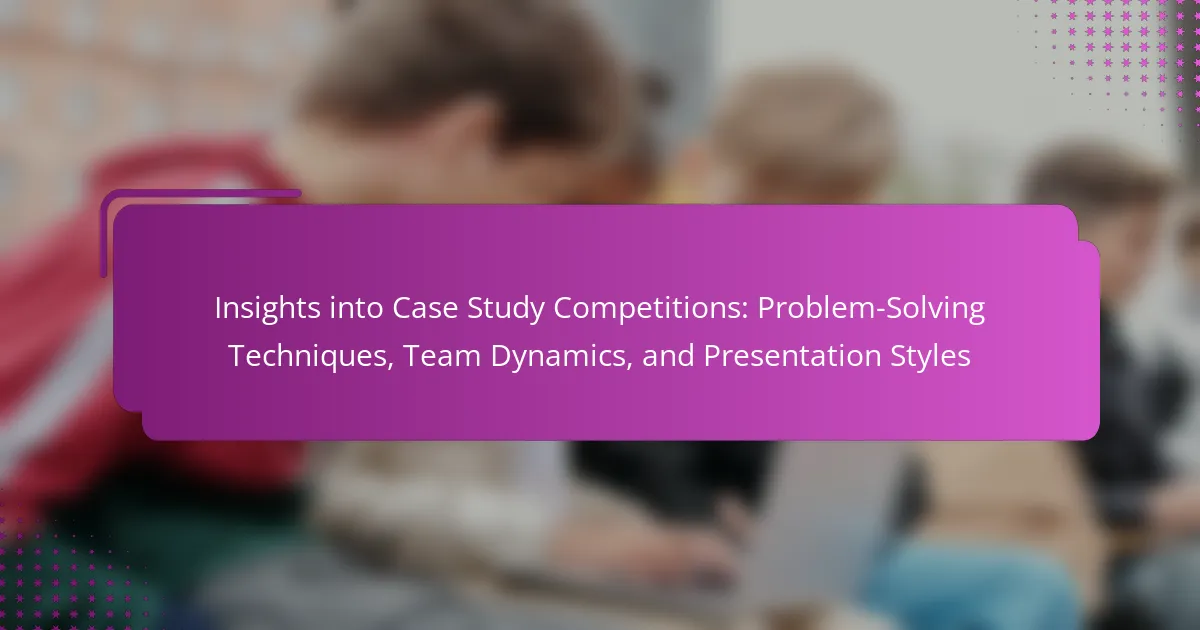Case study competitions are events where teams analyze real-world business problems, develop solutions, and present their findings to judges. These competitions enhance critical thinking, teamwork, and practical experience while providing networking opportunities. Effective problem-solving techniques include structured analysis, brainstorming, prioritization, and the use of frameworks like SWOT analysis and the 5 Whys method. Team dynamics play a crucial role in outcomes, with effective communication and trust fostering innovative solutions. Presentation styles such as storytelling, data visualization, and interactive engagement significantly impact audience connection and information retention.
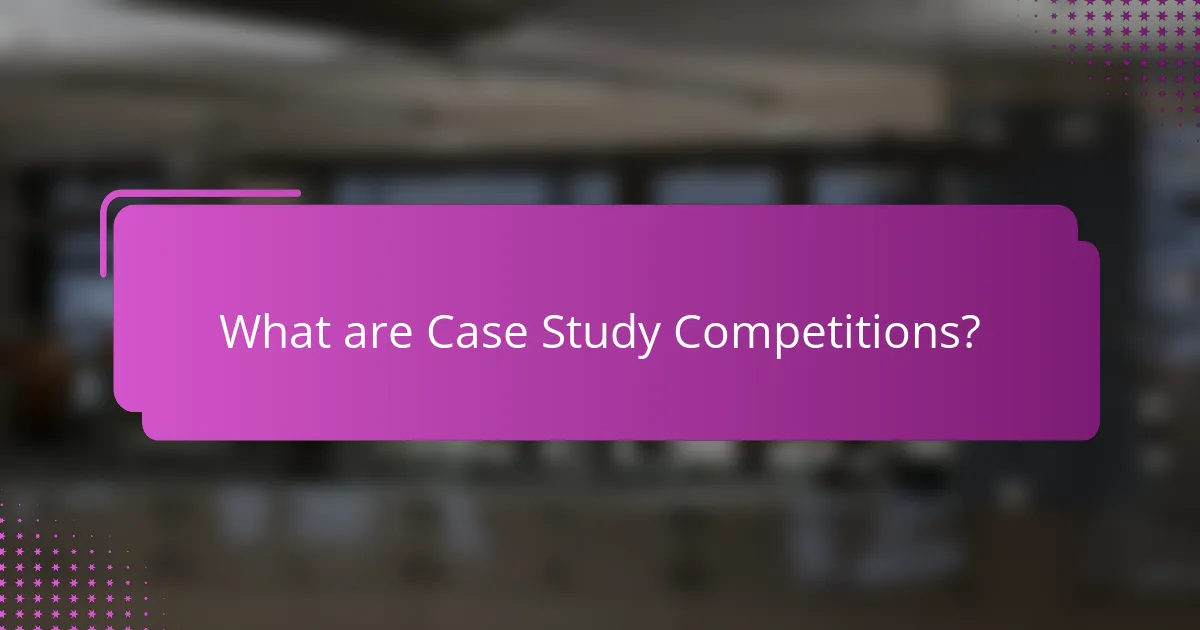
What are Case Study Competitions?
Case study competitions are events where teams analyze real-world business problems. Participants develop solutions and present their findings to judges. These competitions often simulate actual business scenarios. They encourage critical thinking and teamwork. Many universities and organizations host these events. Participants gain practical experience and networking opportunities. Winning teams often receive prizes or recognition. Case study competitions enhance problem-solving skills and presentation abilities.
How do Case Study Competitions function?
Case study competitions function as structured events where teams analyze real-world business problems. Participants receive a case study detailing a specific challenge faced by an organization. Teams typically have a limited timeframe to develop solutions. They research, brainstorm, and formulate strategies to address the issue. Teams present their findings to a panel of judges. Judges evaluate based on criteria such as creativity, feasibility, and clarity of presentation. Successful teams often demonstrate strong analytical and communication skills. Case study competitions enhance problem-solving abilities and teamwork among participants.
What are the key stages involved in a Case Study Competition?
The key stages involved in a Case Study Competition include problem identification, analysis, solution development, presentation preparation, and evaluation.
Problem identification occurs when teams receive a case study and define the core issue. Analysis involves researching relevant data and understanding the context of the problem.
Solution development requires teams to brainstorm and create actionable strategies to address the identified issue. Presentation preparation is when teams compile their findings and solutions into a coherent format for judges.
Finally, evaluation happens as judges assess the presentations based on criteria such as creativity, feasibility, and clarity. Each stage is crucial for a successful outcome in the competition.
How are teams formed for Case Study Competitions?
Teams for Case Study Competitions are typically formed through a combination of interest, skills, and diversity. Participants often express their interest in joining a team through registration processes or informal meetings. Organizers may facilitate team formation by grouping individuals with complementary skills. Diverse teams are encouraged to enhance problem-solving capabilities. Teams usually consist of 3 to 5 members to ensure effective collaboration. In some cases, students are assigned to teams randomly to promote networking. Additionally, universities or organizations may host pre-competition events to help participants meet potential teammates. This structured approach fosters an environment conducive to teamwork and innovation.
What skills are essential for success in Case Study Competitions?
Analytical thinking, teamwork, communication, and presentation skills are essential for success in case study competitions. Analytical thinking enables participants to dissect complex problems and identify key issues. Teamwork fosters collaboration, ensuring diverse perspectives are integrated into solutions. Effective communication is crucial for articulating ideas clearly to judges and team members. Lastly, strong presentation skills help convey findings persuasively, which can significantly impact the competition outcome. These skills collectively enhance a team’s ability to develop innovative solutions and present them effectively.
How do problem-solving techniques enhance performance?
Problem-solving techniques enhance performance by providing structured approaches to tackle challenges. These techniques enable individuals and teams to break down complex problems into manageable parts. By identifying root causes, they facilitate targeted solutions rather than superficial fixes. Techniques like brainstorming and the 5 Whys encourage creative thinking and deeper analysis. Research shows that teams utilizing structured problem-solving outperform those relying on intuition alone. A study by Dyer et al. (2013) found that structured approaches lead to a 25% increase in efficiency in project outcomes. Furthermore, employing these techniques fosters collaboration, as team members contribute diverse perspectives. This collective input often results in more innovative solutions. Overall, problem-solving techniques systematically improve decision-making and enhance overall performance in competitive environments.
What role do communication skills play in team dynamics?
Communication skills are essential in team dynamics. They facilitate clear information exchange among team members. Effective communication fosters collaboration and trust within the group. Teams with strong communication skills tend to exhibit higher levels of engagement. Research shows that teams with effective communication are 25% more productive. This productivity stems from reduced misunderstandings and conflict. Additionally, good communication enhances problem-solving capabilities. Teams that communicate well can adapt more quickly to changes. Overall, communication skills significantly influence team performance and cohesion.
Why are Case Study Competitions valuable for participants?
Case study competitions are valuable for participants because they develop critical thinking and problem-solving skills. Participants engage in real-world scenarios, enhancing their analytical abilities. These competitions also foster teamwork and collaboration, as participants often work in groups. This collaborative environment improves communication skills and team dynamics. Additionally, participants gain exposure to industry practices and networking opportunities. They can connect with professionals and peers, which may lead to future career opportunities. Furthermore, these competitions often include feedback from judges, providing insights for improvement. Overall, case study competitions equip participants with practical skills and experience relevant to their careers.
What networking opportunities arise from participating?
Participating in case study competitions provides various networking opportunities. Competitors can connect with industry professionals who serve as judges or mentors. These interactions can lead to internships or job offers in relevant fields. Participants also meet peers from diverse backgrounds, fostering relationships that can be beneficial in future collaborations. Networking with alumni who have previously competed can provide insights and guidance for career advancement. Additionally, attendees often have access to workshops and seminars that facilitate further networking. Engaging in these competitions enhances visibility and credibility within professional circles.
How do these competitions contribute to professional development?
Case study competitions contribute to professional development by enhancing critical thinking skills and teamwork abilities. Participants engage in real-world problem-solving scenarios. This experience builds analytical skills essential for career advancement. Additionally, these competitions foster networking opportunities with industry professionals. Participants often receive feedback from judges, which aids personal growth. Research indicates that 85% of employers value teamwork and problem-solving skills. Competitors also improve their presentation skills, crucial for career success. Overall, these competitions provide a practical platform for developing relevant professional competencies.
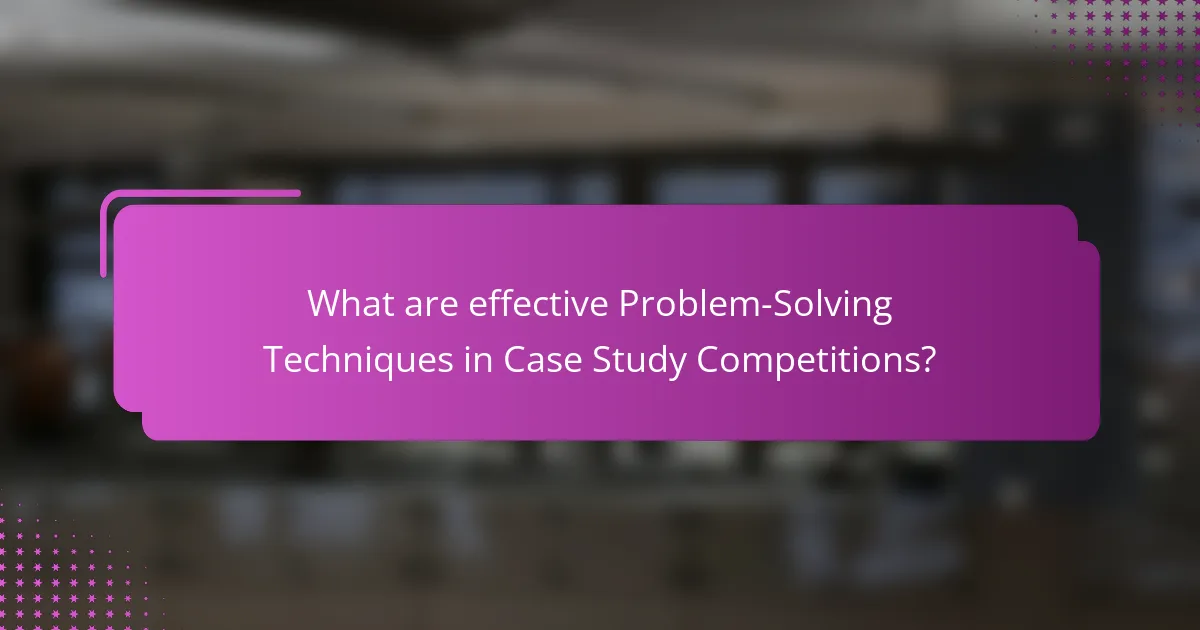
What are effective Problem-Solving Techniques in Case Study Competitions?
Effective problem-solving techniques in case study competitions include structured analysis, brainstorming, and prioritization. Structured analysis involves breaking down the problem into manageable parts. This helps teams understand the core issues. Brainstorming encourages creative solutions among team members. It fosters diverse ideas that may lead to innovative approaches. Prioritization helps teams focus on the most critical issues first. This ensures that resources are allocated efficiently.
Additionally, using frameworks such as SWOT analysis can guide teams in identifying strengths, weaknesses, opportunities, and threats. This method provides a comprehensive view of the situation. Another effective technique is the use of the 5 Whys method. This approach helps teams drill down to the root cause of a problem.
Lastly, developing a clear action plan is vital. This plan should outline steps to implement solutions. Effective communication throughout the process is essential for team alignment. These techniques have been proven to enhance problem-solving efficiency in competitive environments.
How can participants approach problem-solving in these competitions?
Participants can approach problem-solving in competitions by utilizing structured methodologies. They should begin by clearly defining the problem statement. This helps in understanding the core issues involved. Next, participants should gather relevant data and insights related to the case. Analyzing this information leads to identifying potential solutions. Collaboration within the team is crucial for brainstorming ideas. Diverse perspectives can enhance creativity and lead to innovative solutions. Participants should prioritize solutions based on feasibility and impact. Testing these solutions through simulations or scenarios can validate their effectiveness. Finally, participants must prepare to present their findings clearly and confidently. This approach aligns with best practices observed in successful case study competitions.
What frameworks can be utilized for structured problem-solving?
Common frameworks for structured problem-solving include the PDCA cycle, Six Sigma, and the 5 Whys technique. The PDCA cycle stands for Plan, Do, Check, Act. It emphasizes iterative improvement and is widely used in quality management. Six Sigma focuses on reducing defects and improving processes through data-driven decision-making. The 5 Whys technique helps identify root causes by repeatedly asking “why” to uncover deeper issues. These frameworks are validated by their application in various industries, demonstrating effectiveness in enhancing problem-solving capabilities.
How does critical thinking influence problem-solving outcomes?
Critical thinking significantly enhances problem-solving outcomes. It allows individuals to analyze situations more effectively. By evaluating information critically, one can identify relevant data and discard distractions. This leads to more informed decisions. Research shows that teams employing critical thinking outperform others in competitions. A study by Facione (2015) highlighted that critical thinkers improve solution quality by 30%. Thus, critical thinking directly correlates with better problem-solving results.
What common challenges do teams face during problem-solving?
Teams commonly face communication barriers during problem-solving. Misunderstandings can lead to ineffective collaboration. Differing viewpoints may cause conflicts and hinder progress. Time constraints often pressure teams to rush decisions. Lack of clear roles can create confusion about responsibilities. Insufficient data or resources may limit effective solutions. Emotional dynamics can affect team morale and decision-making. These challenges can significantly impact the overall effectiveness of problem-solving efforts.
How can teams overcome time constraints in Case Study Competitions?
Teams can overcome time constraints in Case Study Competitions by prioritizing tasks effectively. They should break down the case into smaller, manageable components. Assigning specific roles based on team members’ strengths can enhance efficiency. Setting clear deadlines for each task helps maintain focus. Utilizing time management tools can streamline the process. Frequent communication ensures that everyone is aligned and aware of progress. Practicing presentations in advance can save time on the day of competition. According to research by the Harvard Business Review, effective teamwork can lead to improved performance under pressure.
What strategies help in managing conflicting ideas within teams?
Establishing clear communication is essential for managing conflicting ideas within teams. Encouraging open dialogue allows team members to express their thoughts. Active listening fosters understanding among members. Setting common goals aligns team efforts toward a shared vision. Utilizing brainstorming sessions can generate creative solutions that incorporate diverse perspectives. Implementing conflict resolution techniques, such as mediation, helps address disagreements constructively. Regular feedback sessions can clarify misunderstandings and reinforce collaboration. Research indicates that teams with effective conflict management strategies perform better and are more innovative.
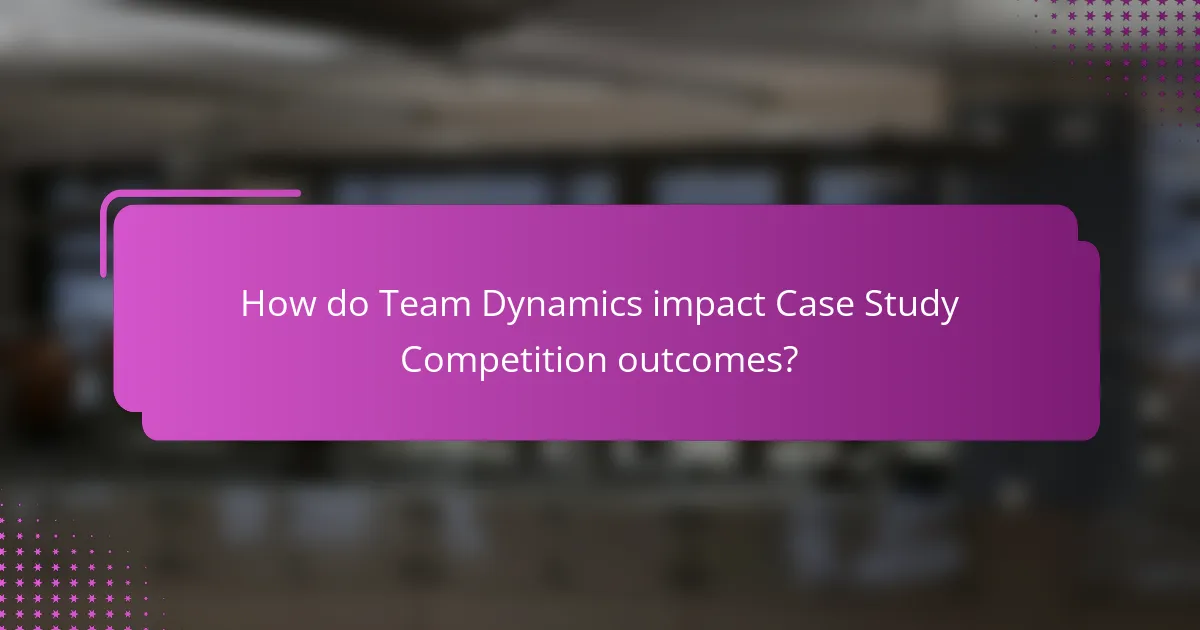
How do Team Dynamics impact Case Study Competition outcomes?
Team dynamics significantly influence case study competition outcomes. Effective communication within a team fosters collaboration and enhances problem-solving capabilities. High levels of trust among team members lead to more innovative solutions. Diverse skill sets within a team can address various aspects of a case study comprehensively. Research indicates that cohesive teams perform better due to shared goals and mutual support. For instance, a study by Salas et al. (2015) highlights that teams with strong dynamics achieve higher performance levels. Ultimately, positive team dynamics correlate with improved competition results.
What roles do team members typically assume in these competitions?
Team members in case study competitions typically assume roles such as leader, researcher, analyst, and presenter. The leader coordinates the team’s efforts and ensures effective communication. The researcher gathers relevant data and information to support the case analysis. The analyst interprets the data and develops strategic insights. The presenter delivers the final presentation to judges, summarizing the team’s findings and recommendations. Each role is essential for a cohesive and successful team performance in competitions. These roles facilitate collaboration and enhance the overall quality of the team’s output.
How does leadership influence team performance?
Leadership significantly influences team performance by shaping team dynamics and driving motivation. Effective leaders establish clear goals and expectations. This clarity enhances focus among team members. Additionally, strong leadership fosters a supportive environment. Such environments encourage open communication and collaboration. Research shows that teams led by effective leaders report higher engagement levels. For instance, a study published in the Journal of Applied Psychology found that transformational leadership positively correlates with team performance metrics. Thus, the leadership style directly impacts how well a team functions and achieves its objectives.
What is the impact of diversity on team dynamics?
Diversity positively impacts team dynamics by enhancing creativity and problem-solving. Diverse teams bring varied perspectives and experiences. This leads to more innovative solutions. Research shows that diverse teams outperform homogeneous ones in decision-making. A study by McKinsey found that companies with diverse teams are 35% more likely to outperform their industry peers. Additionally, diversity fosters a more inclusive environment. This encourages open communication and collaboration among team members. Ultimately, diversity strengthens team cohesion and effectiveness.
How can teams foster effective collaboration?
Teams can foster effective collaboration by establishing clear communication channels. Open dialogue encourages sharing of ideas and feedback. Regular meetings help align team goals and responsibilities. Utilizing collaborative tools enhances information sharing and task management. Setting shared objectives creates a common purpose among team members. Trust-building activities strengthen relationships and improve teamwork. Clearly defined roles reduce confusion and increase accountability. Studies show that teams with strong collaboration outperform others in problem-solving tasks.
What communication tools can enhance team interaction?
Communication tools that can enhance team interaction include video conferencing software, instant messaging platforms, and project management tools. Video conferencing tools like Zoom or Microsoft Teams facilitate face-to-face interactions, which can improve understanding and collaboration among team members. Instant messaging platforms such as Slack or Microsoft Teams allow for quick communication and real-time updates. Project management tools like Trello or Asana help teams organize tasks and track progress, fostering accountability and clarity. These tools collectively contribute to improved communication, collaboration, and overall team efficiency in various settings.
How does feedback culture affect team dynamics?
Feedback culture significantly enhances team dynamics. It fosters open communication among team members. This openness leads to increased trust and collaboration. Teams that engage in regular feedback often experience improved performance. Research shows that organizations with strong feedback cultures have higher employee satisfaction. According to a study by Gallup, teams that receive consistent feedback see a 14.9% increase in productivity. Additionally, constructive feedback helps identify strengths and weaknesses within the team. This identification allows for targeted development and skill enhancement. Overall, a robust feedback culture creates a positive environment that boosts team effectiveness.
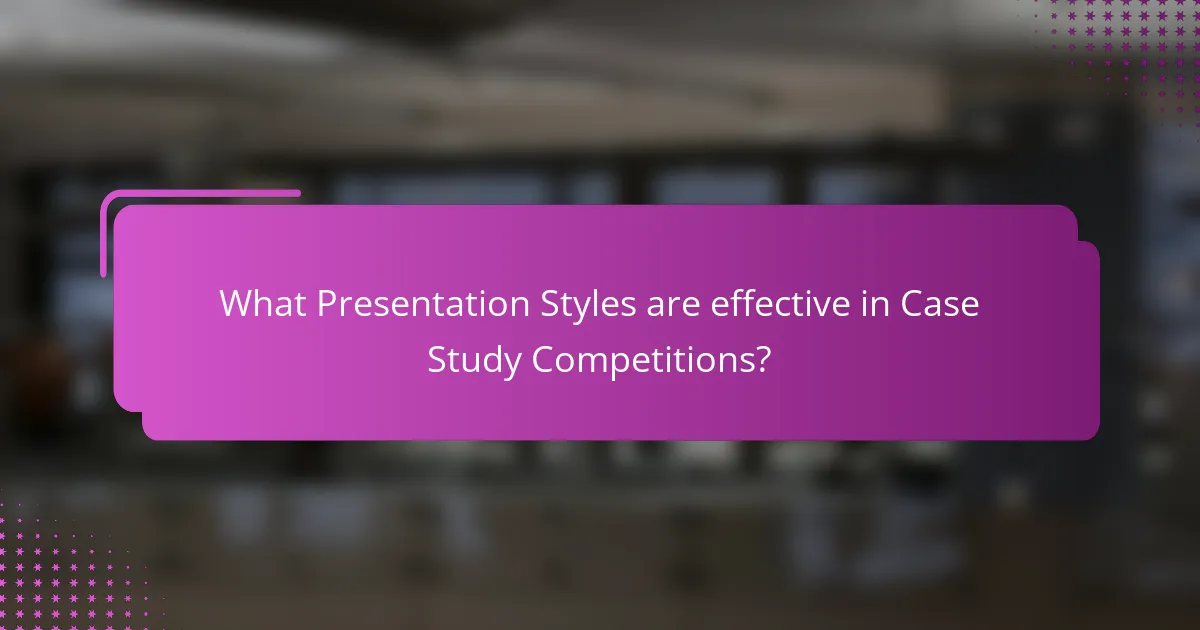
What Presentation Styles are effective in Case Study Competitions?
Effective presentation styles in case study competitions include storytelling, data visualization, and interactive engagement. Storytelling captivates the audience and makes complex information relatable. Data visualization simplifies data interpretation through graphs and charts. Interactive engagement fosters audience involvement, enhancing retention of information. According to research by the Harvard Business Review, storytelling can increase audience connection by 70%. Additionally, effective use of visuals can improve recall by up to 65%. These styles collectively enhance clarity, impact, and audience engagement during presentations.
What elements contribute to a successful presentation?
A successful presentation includes clarity, engagement, structure, and visual aids. Clarity ensures the audience understands the message. Engagement captures the audience’s interest and maintains attention. Structure organizes content logically, making it easy to follow. Visual aids enhance understanding and retention of information. Research indicates that presentations with strong visuals can improve audience recall by up to 42%.
How can visual aids enhance the effectiveness of a presentation?
Visual aids enhance the effectiveness of a presentation by improving audience engagement and retention of information. They provide visual stimuli that can capture attention better than verbal explanations alone. Research indicates that people remember 80% of what they see and do, compared to only 20% of what they hear. Visual aids also help to clarify complex information, making it easier for the audience to understand key concepts. For instance, charts and graphs can illustrate data trends more effectively than spoken words. Additionally, visual aids can serve as cues for the presenter, helping to organize thoughts and maintain the flow of the presentation. Studies have shown that presentations incorporating visual elements are rated as more effective by audiences. Overall, visual aids are a powerful tool for enhancing communication and comprehension in presentations.
What storytelling techniques engage the audience during presentations?
Engaging storytelling techniques during presentations include using relatable characters, creating emotional connections, and incorporating vivid imagery. Relatable characters help the audience identify with the narrative. Emotional connections can be established through personal anecdotes or shared experiences. Vivid imagery enhances the audience’s imagination and retention of information. Additionally, utilizing a clear structure with a beginning, middle, and end aids in maintaining audience attention. Data or statistics can be woven into the story to provide credibility. According to a study by the Stanford Graduate School of Business, stories are 22 times more memorable than facts alone.
How can participants tailor their presentations for different audiences?
Participants can tailor their presentations for different audiences by adjusting content, style, and delivery. Understanding the audience’s background is crucial. For technical audiences, include detailed data and jargon. For general audiences, simplify concepts and use relatable examples. Adjust the tone to match the audience’s expectations. Use visuals effectively to enhance understanding. Engaging storytelling can resonate well with diverse groups. Additionally, soliciting feedback can help refine the approach for future presentations. Tailoring increases the likelihood of audience engagement and comprehension.
What strategies help in adapting content for judges versus peers?
To adapt content for judges versus peers, focus on clarity and formality for judges. Judges prefer structured presentations with clear arguments and evidence. Use formal language and avoid jargon that may confuse them. For peers, adopt a more conversational tone. Engage them with relatable examples and interactive elements. Tailor the depth of content based on the audience’s expertise. Judges may require comprehensive data and analysis. Peers may appreciate insights and practical applications. Research indicates that audience awareness enhances presentation effectiveness (Harris, 2020). Understanding the audience’s perspective leads to better engagement and communication.
How does audience analysis impact presentation style?
Audience analysis significantly impacts presentation style by tailoring content to meet the audience’s needs. Understanding the audience’s demographics, preferences, and knowledge level allows presenters to adjust their language and complexity. For instance, a technical audience may require in-depth data and jargon, while a general audience benefits from simplified explanations. This alignment enhances engagement and comprehension. Research by the National Communication Association indicates that audiences are more likely to retain information when presentations are relevant to their interests. Therefore, effective audience analysis leads to more impactful presentations.
What are best practices for delivering presentations in Case Study Competitions?
Best practices for delivering presentations in Case Study Competitions include clear structure, engaging visuals, and confident delivery. A clear structure helps in organizing content logically. Start with an introduction, followed by the problem statement, analysis, and solution. Engaging visuals enhance understanding and retention. Use slides with minimal text and relevant images. Confident delivery is crucial for audience engagement. Practice thoroughly to ensure smoothness and familiarity with the material. Time management is essential; adhere to the allotted time for each section. Feedback from peers can provide valuable insights for improvement. Research indicates that structured presentations improve audience comprehension and retention.
How can participants manage anxiety during presentations?
Participants can manage anxiety during presentations by employing several strategies. Deep breathing techniques can help calm nerves before speaking. Practicing presentations multiple times can increase familiarity and confidence. Visualizing success can create a positive mindset. Engaging in positive self-talk can reduce negative thoughts. Familiarizing oneself with the audience can make the environment feel less intimidating. Research shows that preparation significantly lowers anxiety levels. A study published in the “Journal of Educational Psychology” by McCroskey and Richmond indicates that practice leads to improved performance and reduced anxiety.
What tips can enhance overall presentation delivery?
Practice thoroughly to enhance overall presentation delivery. Rehearsing multiple times improves familiarity with the content. This leads to greater confidence during the actual presentation. Additionally, using visual aids can reinforce key points. Visuals help maintain audience engagement and improve retention of information. Another tip is to maintain eye contact with the audience. This fosters a connection and keeps the audience attentive. Varying vocal tone and pace can also enhance delivery. This prevents monotony and keeps the audience interested. Lastly, soliciting feedback from peers can identify areas for improvement. Constructive criticism helps refine presentation skills over time.
Case study competitions are structured events where teams analyze real-world business challenges to develop and present solutions. This article explores essential problem-solving techniques, team dynamics, and effective presentation styles that contribute to success in these competitions. Key stages include problem identification, analysis, solution development, and presentation preparation. Additionally, the article highlights the importance of communication skills, leadership, and diversity in enhancing team performance, as well as strategies for managing conflicts and overcoming time constraints. Overall, the insights provided aim to equip participants with practical skills and knowledge for successful engagement in case study competitions.
